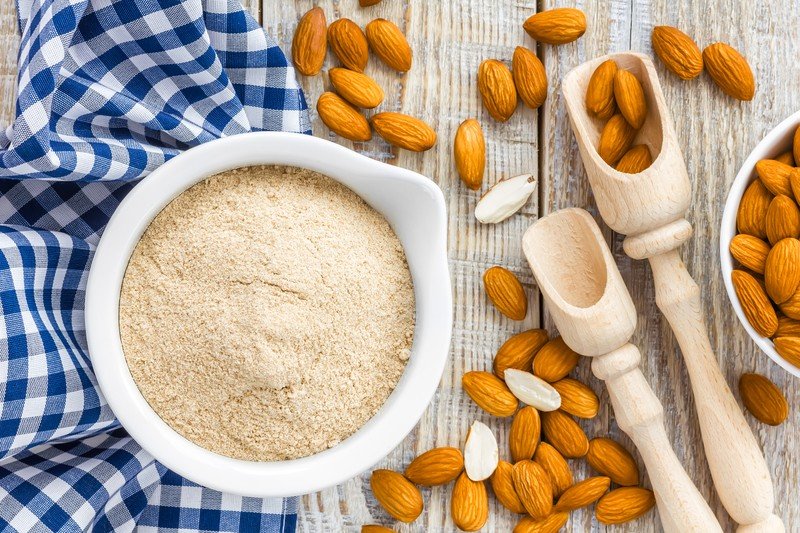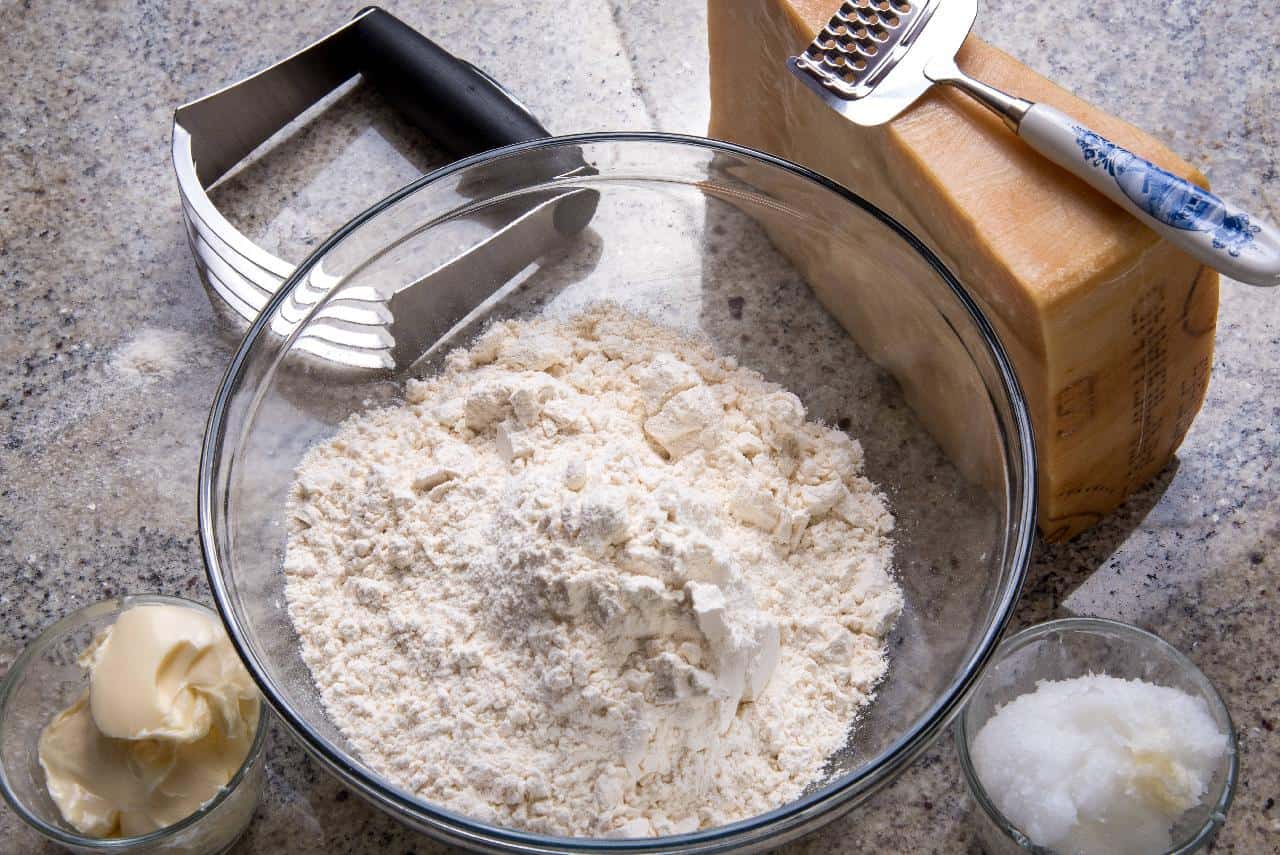Almond flour is one of the healthiest flour alternatives you can find. When someone is looking for a gluten free alternative to traditional flour, almond flour is almost always their first choice.
Almond flour can be used in place of traditional flour in almost any recipe. Since the flour is made from ground almonds, the taste is unique and a little sweeter than all purpose flour. It also is bursting with nutrients that all purpose flour simply cannot compete with.
Not to be confused with almond meal, which is also made of almonds, almond flour is made by blanching almonds, removing their skin, and crushing them to a fine powder.
Almond meal, on the other hand, is made with a similar process, only the almond’s skin remains intact. This creates an entirely different texture and color.
It is important to keep this in mind when you are reading recipes calling for either almond flour or almond meal.
Why Should I Use Almond Flour?
Almond flour seems to be becoming a front runner for flour choices for cooking or baking and for good reason. Compared to traditional all purpose flour, almond flour is full of nutrients and vitamins.
Almond flour is bursting with vitamin E which acts as an antioxidant in your body. Almond flour is also rich in magnesium which can help the body in many ways including improved blood sugar control, reduced insulin resistance and lower blood pressure.
Almond flour is better for your blood sugar than traditional all purpose flour. When we eat foods that are made of refined wheat, we can spike our blood sugar levels.
Since they are low in fat and fiber, the levels rapidly drop, leaving us feeling tired and sluggish. Then our bodies crave more calories and sugar.
Almond flour is extremely low in carbs and high in healthy fats and fiber, preventing the blood sugar crash from happening. When we swap all purpose flour for almond flour, we can create a more well rounded and balanced meal or snack.
Also check: 10 Best Almond Flour Substitutes
How Do I Substitute Almond or Coconut Flour For All Purpose Flour?
Anyone who has spent any time in the kitchen knows that baking can be complicated.
Unlike cooking which can be adjusted throughout the process, baking needs to be exact and right before it goes into the oven or the recipe will not turn out right.
Swapping ingredients, adding too little or too much of an ingredient, or missing an ingredient all together can render a complete disaster in the kitchen.
So how do you substitute almond or coconut flour for all purpose flour without completely ruining the dish?
For almond flour, conversion is easy. Simply use almond flour in the same quantities you would have used the all purpose flour.
Since the ratio is nearly the same, creating gluten free almond flour recipes from regular recipes can be simple and fun.
You can also use almond flour instead of breadcrumbs when preparing fish, chicken, or beef.
The almonds create the perfect breadcrumb crust that toasts well and adds a unique flavor to the final product. Try adding some herbs like rosemary or thyme for an even more exciting dish.
Even though baking with almond flour is pretty simple conversion wise, there are some things to keep in mind when making the switch from all purpose flour.
First, gluten in all purpose flour is what helps baked goods rise. Using almond flour instead will result in denser and flatter cakes or other baked goods.
Another thing to keep in mind is that almond flour has more calories than all purpose flour. In a comparison, almond flour has 163 calories in one ounce while all purpose flour contains 102 calories per one ounce.
For coconut flour, there is some adjusting. For every 1 cup of all purpose flour, you will need ¼ – ⅓ cup of coconut flour.
Also check:Substitutes for Coconut Flour
Coconut flour is finicky and a bit more difficult to work with than almond flour. For this reason, many people who are gluten free tend to choose to work with almond flour.
Substituting Almond Flour for All Purpose Flour in Cookies
When it comes to using almond flour instead of all purpose flour in cookies, it is an easy swap. Simply use the same amount of almond flour as you would regular all purpose flour in the recipe.
However, almond flour and all purpose flour are incredibly different, despite being used in the same way. Almond flour will give you denser and wider cookies. They will also tend to be flat.
This is because gluten in all purpose flour helps the baked goods rise and allow for air to enter the cookie and get fluffy.
Taste and texture will also be different. Almond flour is much coarser than all purpose flour even when sifted and mixed well.
It can tend to taste a little grainy and have a hard time binding into the ingredients and making a cohesive dough like all purpose flour would.
Keep in mind that you should let your cookies cool completely before attempting to move them when you bake them with almond flour.
Since the almond flour does not bind as well as all purpose flour, the cookies have a much greater chance of falling apart before they have cooled completely.
When baking with all purpose flour, you can allow the cookies to rest for a few minutes before transferring them to a cooling rack.
In the case of almond flour cookies, allow them to cool directly on the sheet pan to prevent crumbled cookies.
Another important thing to consider when baking with almond flour is the taste. Almond flour tastes like, well, almonds.
All purpose flour does not have a taste that is prominent when mixed appropriately into the dough.
However, almond flour will always give a hint of almond flavor regardless of how much or how little it is used in a recipe.
While almonds do taste delicious, you may want to adjust the recipe to accommodate the additional flavors of the almonds.
Adding cranberries and sliced almonds instead of chocolate chips would be a great way to play up the almond flour’s natural taste.
Also check: Almond Flour Vs. All Purpose Flour
Other Substitutes for All Purpose Flour
If you do not want to use almond flour, there are plenty of other alternatives out there.
Almost anything can be grinder and sifted down into a flour consistency and with a rise in gluten free, paleo, and other dietary restrictions, there are endless possibilities for baking without all purpose flour.
Chickpea powder may be new to many American households, but it has been a staple in Indian and other culture’s kitchens for centuries.
This alternative is made of chickpeas which are also called garbanzo beans. Chickpea powder is also called besan. While it is not used much in baking, chickpea powder is known for its binding power.
It requires very little water or oil before it will bind to just about anything. Chickpea powder is commonly used in the batter for tandoori recipes. The mixture is used as a binder to help keep spices on the skin of the chicken.
Rice flour is another great option that is relatively new to American kitchens but has been a staple in Asian households across the world.
The most common way that rice flour is used is to thicken curries and sauces, similar to the way we use cornstarch.
Rice flour is also a well guarded secret ingredient when it comes to making anything fried remain light and airy.
If you are hoping to mimic Korean fried chicken, Japanese tempura, or want to create a new take on fried food in your own home, rice flour may be the option for you.
When it comes to baking, coconut or buckwheat flour are competing with almond flour as the front runner for gluten free baking ingredients.
Even though buckwheat sounds like it would have wheat in it, it is actually a seed ground into a flour.
Buckwheat flour is definitely the new “it” flour being made into everything from cookies to pancakes.
Coconut flour remains one of the more finicky and hard to work with gluten free flours and can create a lot of issues.
For that reason, many people prefer to work with almond or buckwheat flours.
Summary
Today, there are many options for those hoping to enjoy baked good or fried foods without gluten or all purpose flour. Almond flour is one of the best alternatives to all purpose flour.
Almond flour is full of nutrients and vitamins. That plus the fact that it does not have any gluten, makes it a great option for both the health conscious as well as those with a gluten intolerance.
Luckily, baking with almond flour is pretty straight forward. Using almond flour at a ratio of 1:1 with all purpose flour, recipes are easy to convert.
There are endless possibilities and flavor profiles that you can create using and exploring gluten free options like almond flour or coconut flour in your kitchen





1 comment
Hi Saurabh, I love reading all about Almond flour instead of using plain flour. I am a diabetic, please can you give me the amount of Almond flour to self raising flour? Could i put baking powder to help my flour to rise abit? Thank you Dawn.